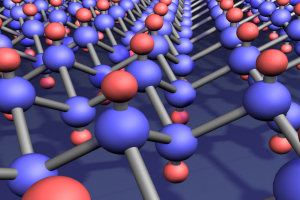Professor André Geim, winner of the 2010 Nobel Prize in Physics for the discovery of graphene - the thinnest material known to science today - has now modified it and turned it into fluorographene - a material with a thickness of one fara that is chemically similar to the familiar material Teflon

Scientists from the University of Manchester have prepared a new material that could replace or compete with the familiar material Teflon used in many applications, at home and abroad.
Professor Andre Geim, winner of the Nobel Prize in Physics in 2010 for the discovery of graphene - the thinnest material known to science today - has now changed it and turned it into fluorographene - a material with a thickness of one fara that is chemically similar to the material known to all Teflon. Fluoro-graphene is graphene that has been completely transformed with fluorine atoms and is actually the two-dimensional form of Teflon, and has similar properties, including chemical resistance and heat stability.
The research findings were published in the online version of the scientific journal Small. The research was the result of a broad international effort that included research groups from China, the Netherlands, Poland and Russia.
The researchers hope that fluorographene - a crystalline and flat form of Teflon that is as rigid as graphene - can be used as a thinner and lighter-weight substitute for Teflon, as well as in diverse applications in the fields of electronics, optics and physics.
Graphene, a single-atom-thick material with a wide spectrum of unique and unusual properties, has been at the center of scientific attention since its groundbreaking discovery at the University of Manchester six years ago. The potential of this material is almost inexhaustible - from extremely fast transistors to sensors that can detect a single particle of toxic gas and even as a replacement for carbon fibers in composite materials used in the construction of fighter planes.
Professor Geim and his research team have taken a new perspective by looking at graphene as a giant foil that, like many other foils, can be modified through chemical reactions.
Teflon is a chain of carbon atoms that is completely transformed with fluorine atoms (in place of the hydrogen atoms that were originally there). A collection of these long chains, linked together, make up the Teflon polymer material used in a variety of applications including non-stick pans.
The research team was able to connect fluorine atoms to the carbon atoms in graphene. To do this, the researchers first prepared single crystals of graphene and then reacted them with fluorine atoms in a chemical reaction. In order to demonstrate the ability to obtain the new material on an industrial scale, the researchers prepared fluorographene paper from graphene powder.
The scientists discovered that fluorographene is a high-quality insulating material, it does not react with other chemicals and it is resistant to high temperatures, even in air.
One of the most vigorous directions in graphene research is the desire to take advantage of its spectrum of electronic properties, that is - preparing a semiconductor with a wide range from metallic graphene. This ability will open a window to many new applications in the fields of electronics. It was found that fluoro-graphene is a semiconductor with a wide spectrum, it is transparent to visible light, and this is in contrast to graphene which is defined as a semi-metal.
Professor Game explains: "We need to improve the electronic quality of fluorographene before we start talking about its possible applications in electronics, but other applications are much closer." Adds one of the research partners: "The properties of fluorographene are remarkably similar to those of Teflon, but the material is not plastic. The material is actually a perfect crystal with a thickness of a single atom, and like its "father" graphene, it is also mechanically strong. This feature allows the development of applications that did not exist before. For example, we intend to use fluorographene as an ultra-thin transfer component for the development of light-emitting devices and diodes."
"Simpler applications could be those where Teflon is used today, such as a very thin protective coating, or as a filler for composite materials if the mechanical strength of graphene needs to be utilized while still avoiding the electrical conductivity or the optical opacity of the original material."
The industrial production of fluorographene should not be a special challenge since it will be based on the same steps in the commercial production of graphene itself. The researchers believe that the next important step will be to prepare prototype devices that will demonstrate the unique capabilities of the new material.
Professor Geim adds: "There is no point in using it as a pure replacement for Teflon. The combination of the special properties of graphene and Teflon is so enticing that you don't have to stretch your creativity too much to think of possible applications of XNUMXD Teflon. The challenge is indeed to take advantage of this uniqueness."

7 תגובות
Let's get down to business - literally.
With glue
I don't understand how you stick the Teflon to the pan if it's not supposed to stick to any surface
Bravo
You have never tasted an omelet until you have tasted an omelet fried on two-dimensional fluoro-graphene!
Sorry for the ignorance but what practical application could a one molecule thick surface have? A gust of wind, an accidental burst of radiation or a tiny change in temperature, and the surface will disappear or oxidize